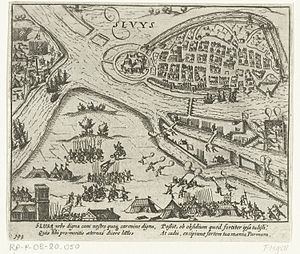 | ||
700 killed and 400 wounded 92 killed and 243 wounded Similar Siege of Hulst, Siege of Lingen, Siege of Grave, Siege of Knodsenburg, Siege of Oldenzaal | ||
The Siege of Sluis of 1587 took place between 12 June and 4 August, 1587, as part of the Eighty Years' War and the Anglo-Spanish War (1585–1604). On 12 June, 1587, Don Alexander Farnese, Duke of Parma (Spanish: Alejandro Farnesio), Governor-General of the Spanish Netherlands, and commander-in-chief of the Army of Flanders, laid siege to the strategic deep-water port of Sluis, defended by English and Dutch troops under Sir Robert Dudley, Earl of Leicester, Governor-General of the United Provinces, and Sir Roger Williams. On 24 June, the bombardment began, and on 4 August, after of 13 days of constant fighting around the walls, the English garrison surrendered. The lost of the English-held port of Sluis revealed the inability of Leicester to assert his authority over the Dutch allies, who refused to cooperate in relieving the town, and led to recriminations between the Governor-General and the States of Holland.
Other notable English soldiers under Leicester's command were Sir Thomas Baskerville and Sir Francis Vere. In the following months, the Earl of Leicester launched a series of unsuccessful attacks against the Spaniards. In September, 1587, Leicester attempts to capture Leiden, but failed, and his plans to capture Enkhuizen and Hoorn, two important ports of West Friesland, also failed. On 16 December, 1587, Leicester returned to England.
